It’s officially fall and that means colder temperatures are here to stay. In my opinion, nothing is better on a chilly day than lighting a fire, hearing it crackle and warming up around it.
Whether your fire is indoors or outside, the way the smoke moves tells a big story about what’s coming weather-wise.
There is an old saying that says, ‘when chimney smoke descends, our nice weather ends.’ The saying is catchy, there’s no doubt about that, but is it true? The answer is yes.
On a clear, chilly night in the fall or winter when you light a fire, you may notice that the smoke from that fire usually goes straight up into the sky. While that happens most of the time, it doesn’t always occur that way.
Sometimes you’ll notice smoke hovering overhead. The weather is to blame for that.
When a storm is nearby and approaching the area, there is more moisture in the air. The particles of smoke get caught on the droplets of water in the atmosphere ahead of that storm and make them heavier.
Instead of rising freely, the smoke gets dragged down and you’ll see it and smell it around you and your home. That is a sign of either rain or snow in the near future—some say within 24 hours.
On the other side of the coin, in dry and calm weather, chimney smoke rises vertically, and that shows that fair clear weather is around and it will stay that way in the short term.
The way the smoke behaves is another way to look at and discuss stable vs. unstable air masses. While studying meteorology in college, we looked at smoke stacks and smoke plumes in order to help determine what type of air mass is overhead. The shape of a plume of smoke can also help deduce what type of atmospheric conditions to expect.
Although this folklore doesn’t always prove 100% accurate, it’s a quick and easy way to get an idea of the forecast if you’re out sitting around a fire or just don’t have access to a TV the Spectrum News App.
For more weather blogs follow Meteorologist Kaylee Wendt on Facebook, Instagram, and Twitter!
Our team of meteorologists dives deep into the science of weather and breaks down timely weather data and information. To view more weather and climate stories, check out our weather blogs section.



